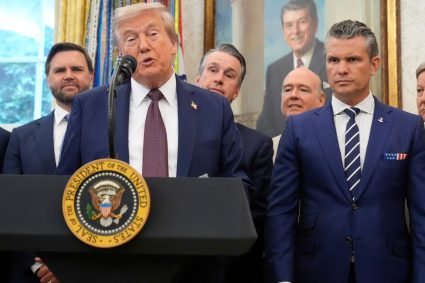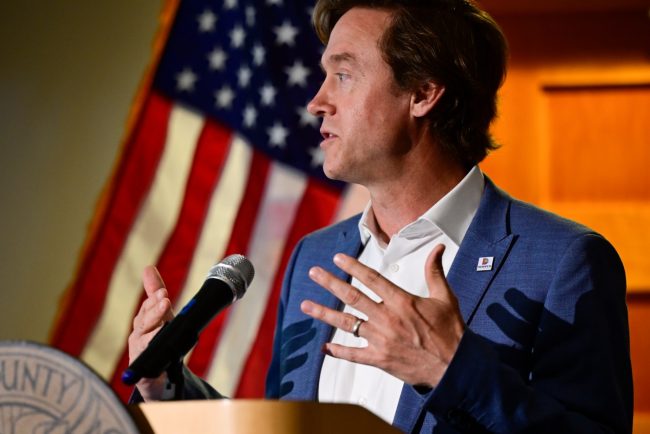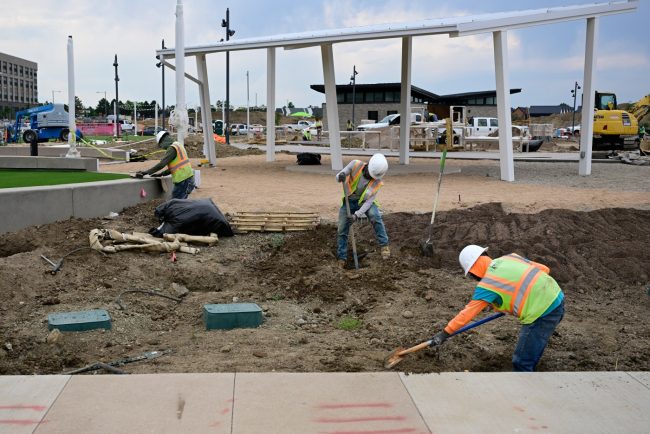
They fled the Taliban, legally entered the U.S. and now Trump is detaining them (Opinion)
Music was the topic in our English practice session. “What is music like in Afghanistan?” one of us asked. “Music not allowed,” said one of the women. “Taliban,” said another pantomiming the bucking recoil of a machine gun. “Hurt you.” If these women are ever […]
Columnists
The pleasures — and perils — of seasonal jobs in the backcountry, on rivers or snow (Opinion)
I was a student at Western Colorado University in Gunnison when my professor told our class he had a message for anyone wanting to work as a seasonal in the outdoor industry after graduating. His message was simple: “Get out of my classroom.” It wasn’t […]
Columnists
The U.S. Air Force Academy is on the brink of failure. Here’s how to save it. (Opinion)
In an April Denver Post column, together with 91 cosigners, including various distinguished military thought leaders, I warned that leadership at the U.S. Air Force Academy was de-emphasizing academic excellence. I reported the majority sentiment surrounding me at the time, as a visiting professor from […]
Columnists


Trump punishes Colorado for voting against him by moving Space Command (Editorial)
President Donald Trump gave two reasons for why he is stripping Space Command from El Paso County in Colorado and moving the headquarters to Huntsville, Alabama – neither of which was true. First, he said voters in Alabama supported his re-election in 2024 by 47 […]
OpinionPresident Donald Trump gave two reasons for why he is stripping Space Command from El Paso County in Colorado and moving the headquarters to Huntsville, Alabama – neither of which was true.
First, he said voters in Alabama supported his re-election in 2024 by 47 points.
Second, he said that Colorado’s mail-in ballots allow election fraud.
The president of the United States held a press conference on a major decision and told Americans that it was based on his political popularity in one state and a gross lie that he has perpetuated since he lost his first bid for re-election and tried to illegally remain in office.
So we will set the record straight.
Trump won Alabama by almost 31 points in 2024.
Funny thing is that he also won El Paso County in 2024 – by almost 10 points.
Guess that wasn’t enough to sway the president’s decision as he callously explained.
“We love Alabama. I only won it by about 47 points. I don’t think that influenced my decision, though, right? Right?” Trump quipped with Alabama Sen. Katie Britt standing to one side and Secretary of Defense Pete Hegseth standing on the other, sharing in a laugh because we all know the answer to that rhetorical question.
We’ve detailed all the ways that keeping the Space Command in El Paso County at Peterson Space Force Base makes sense. It would save time and money by not moving the temporary headquarters out of state. It allows for vast efficiencies because of its proximity to other key military bases in Colorado Springs – the National Space Defense Center, the U.S. Northern Command, North American Aerospace Defense Command, Cheyenne Mountain Space Force Station, and the U.S. Air Force Academy.
The Air Force Academy is producing new cadets for the Space Force every year, and Space Force also has a significant presence at Aurora’s Buckley Space Force Base.
Trump isn’t the first president to make a politically motivated decision like this, but he is the first to gloat openly about using his power to punish a state for not supporting his re-election. The message the president is sending is clear — get on board with team Trump or he will try to hurt your state. Trump could have instead lauded Huntsville’s infrastructure or mentioned “Rocket City’s” low cost of living (the main reason Huntsville was selected as the new home for the command during his first term in office). Trump highlighted the political reasons to move the command to send a warning.
And this is par for the course. Since taking office, Trump has flouted long-held ethical standards meant to protect the American people from a president who is full of anger and wrath, and to prevent corruption of our great nation.
We hope this decision and his attack on Colorado will help sway voters in places like El Paso County when Trump tries to retain office in just a few short years.
“The problem I have with Colorado — one of the big problems — they do mail-in voting. They went to all mail-in voting so they have automatically crooked elections and we can’t have that. When a state is for mail-in voting that means they want dishonest elections,” Trump said. “That played a big factor also.”
Colorado’s mail-in ballots are secure, and despite Trump’s claims, repeated audits done by hand have shown that the 2020 election results in Colorado were not fraudulent. The list of voters who participated in the election is public, and despite hours of scouring the list, there is no evidence that any of those voters are fake.
Ballots are tied to individual voters and were audited in counties across the state.
There is simply no evidence that Colorado’s mail-in elections allow widespread fraud, and certainly no evidence that the ballot machines were rigged as Trump continues to claim, supporting his unconstitutional bid to remain in the White House after he lost in 2020.
But Coloradans should not despair at the unfortunate turn the executive branch has taken.
This bad decision has at least united our entire congressional delegation. Our Republican elected representatives, Jeff Hurd, Jeff Crank, Lauren Boebert and Gabe Evans, joined our Democratic representatives, Diana DeGette, Joe Neguse, Jason Crow, and Brittany Pettersen, in denouncing the move.
U.S. Senators John Hickenlooper and Michael Bennet also joined the letter, making the sentiment unanimous.
“We are united in fighting to reverse this decision,” they wrote. “Bottom line – moving Space Command headquarters weakens our national security at the worst possible time. … Colorado Springs is the appropriate home for U.S. Space Command, and we will take the necessary action to keep it there.”
Well done.
Such a united front gives us hope that, as President Donald Trump continues to exceed his constitutionally granted authority, our elected representatives will stand strong. For now, it is about Space Command, but soon we will need both the House and the Senate to affirm that states are allowed to hold their elections as they see fit without dangerous federal meddling.
Sign up for Sound Off to get a weekly roundup of our columns, editorials and more.
To send a letter to the editor about this article, submit online or check out our guidelines for how to submit by email or mail.

How to bridge the chasm between Colorado’s urban and rural communities (Letters)
We can bridge the rural-urban divide in our state Re: “Why rural Coloradans feel ignored — a resentment as old as America itself,” Aug. 24 commentary Years ago the Colorado Humanities Council (as it was then called), sponsored a marvelous program called the Five States […]
LettersWe can bridge the rural-urban divide in our state
Re: “Why rural Coloradans feel ignored — a resentment as old as America itself,” Aug. 24 commentary
Years ago the Colorado Humanities Council (as it was then called), sponsored a marvelous program called the Five States of Colorado. The divide we have is a regional one, as different areas of the state look at issues differently. In order to celebrate that diversity, especially with Colorado’s upcoming 150th birthday, we ought to reestablish a sister cities and town program in which a variety of communities adopt each other during 2026.
Community leaders can exchange visits, gifts, and events to celebrate not only our unique differences but also common interests that bind us together as a marvelous state.
I think it would be a much better bridge to build, rather than one across Lincoln Street.
Sam Mamet, Denver
As a child of the suburbs and a denizen of cities for almost 70 years, I am compelled to write that I have never in my life felt any antipathy to people who live and work on farms. Nor do I romanticize agricultural life, or urban life for that matter.
Reading this article depicting this divide between urban and rural leaves me with sadness. Here we have yet another example of a divide that separates us. And yet, as the article infers, the divide has been with us since the first cities were created thousands of years ago.
Let us strive to find the connections between us. Let us celebrate our interdependence. My intuition tells me that we will want to rely upon one another more than ever as we address the issues that beset our planet — our shared planet.
Evan Siegel, Westminster
I don’t buy the class comparison of urban people looking down on rural people. I have traveled all over rural America. I have great respect for farmers and ranchers who tend the earth in a sustainable way. The fact is, city-bound corporations are running industrial farming, including livestock raising, relying on chemicals, hormones, feedlots and scarce water for low-value crops like alfalfa for cattle feed. Eating beef the way Americans do is becoming unsustainable for Earth’s climate and water supplies. It is treated as a delicacy for much of the world.
Yes, our fossil fuel consumption is an even greater threat to the planet (and to agriculture). Climate change is creating havoc on agriculture worldwide. But we need to address greenhouse gases across all sectors.
I’m also tired of the wolf debate being framed as urban vs rural. Superficially, that appears to be the case, but lots of Western Slope voters voted in favor. The ranching lobby is still powerful and spread fear of death to our children and ruin of livestock. Many Western Slope ranchers run grazing allotments on public lands that belong to all of us, including urban voters who want to see healthy ecosystems. CPW has removed problem wolves and there is a generous compensation plan for the relatively few animals lost.
Don’t kid yourselves, Trump doesn’t care about agriculture unless he can cut subsidies to fund tax cuts for the rich or to detain migrant workers and send them to foreign prisons.
Karl Ford, Longmont
In her commentary, one of the examples Kayla Gabehart provides is a demonstration of the very real potential for misunderstanding. Regarding the “Meat Out Day” in 2021, she writes, “Typically, gubernatorial proclamations …go largely unnoticed. … And in Denver, Colorado’s metropolitan center, this one did too.”
Perhaps Gabehart should have made clear what “largely unnoticed” meant, since one interpretation could be that no one in Denver that day went without eating meat. And isn’t that, in actuality, what the rural Coloradans wanted?
In this instance, it’s too bad both sides got so caught up in the media spectacle of political sound bites.
Ken Valero, Littleton
While I agreed with many points Kayla Gabehart made in her column, she lost me when she said, “Trump might be their last hope.”
My partner is originally from North Platte, Neb., and we attended her 55th high school reunion. I can say with total certainty that out of all the people that attended the event, we were the only two liberals in the room. This did not surprise me because Nebraska, with the exception of Omaha and Lincoln, is overwhelmingly Republican.
What did surprise me was that these people have voted against their own self-interests. They are facing a crisis where many rural hospitals will be forced to close because of Trump’s policies. He is hurting the agricultural economy with his thoughtless and random tariffs, forcing Nebraska and other rural states to lose valuable international markets for their crops.
I agree with many of Gabehart’s points, but saying that Trump might be their last choice is categorically wrong. Trump cares nothing about the farmers in this country. All he cares about is turning our now fragile Democracy into an authoritarian state.
I just hope rural America realizes this before it is too late.
David Shaw, Highlands Ranch
Good riddance, Dodgers and Padres
Re: “Rockies fans should root for MLB realignment,” Aug. 24 sports commentary
I’ve been reading everything about realignment, and Sean Keeler’s is the first column that makes sense. Most New York papers hate realignment because it would put the high-payroll Yankees, Mets, and Phillies in the same division. A San Francisco sportswriter was upset that realignment would break up the Giants-Dodgers rivalry. Let them have the Dodgers — and the Padres too, whose GM A.J. Preller has a way of orchestrating deals for the top stars.
The Rockies and Diamondbacks have nice stadiums that don’t look like those other ones. So will Las Vegas. So will the new one in Salt Lake City if it happens. I love those four together. The fresh faces of the MLB.
Listen to Mr. Keeler.
Adam Silbert, New York, NY
There are renewable energy options for DIA
Re: “No reason to hate on DIA’s nuclear reactor plans,” Aug. 24 commentary
I can help Krista Kafer, who thinks DIA should study using nuclear power for future energy uses. Wind, solar and batteries would work and be cheaper. A study by energy think tank Ember showed that Las Vegas could be powered 97% of the time by 6 GW of solar and 17 GWh of battery storage at 57% of the cost of nuclear. That’s at today’s prices. Costs are not in for new nuclear tech.
Las Vegas is sunnier than DIA but the study did not include any wind generation. It’s probably windy enough at DIA. Instead of spending $1.25 million on the study, DIA could pay $500,000 to fact-check the Ember study and start building tomorrow — saving $ 750,000 and being ready years ahead.
Nuclear power will face problems with technology and cost because the SMRs are still being developed. Then they must win public opinion in a world where facts and science are not important. Then they need to produce a reactor that meets the current lofty predictions. I would not volunteer to be the first taxpayer for that project.
David Stewart, Aurora
One thing Krista Kafer failed to discuss is that there has been no solution on what to do with the radioactive waste that is produced by nuclear reactors. Because this waste can last for tens of thousands of years before it becomes safe, there needs to be a solution to this problem. Understandably, no one has wanted it to be dumped in their area.
Terry Scott, Greeley
Democrats are facing the consequences
Re: “Democratic Party is facing crisis over voter registration,” Aug. 24 news story
The Democratic Party had two opportunities to show us that they put individual rights and economic reforms favoring ordinary Americans at the forefront of their agenda when they briefly controlled the legislative and executive branches under President Obama and again under President Biden. They failed in both instances.
The successes they touted, the Affordable Care Act and the Economic Recovery Act, though well intentioned and nominally successful, were band-aid solutions that failed to address root problems facing Americans: out of control price increases in health care, housing and post-secondary education; a growing disparity of wealth between the rich and everybody else; and, a rogue Supreme Court, hell bent on paving the way for a new American style feudal system. Biden and the Dems could have blunted SCOTUS excesses by increasing the number of justices when they had the power. They didn’t, thus showing me they weren’t serious reformists.
I fully understand why many have left the Democratic Party. But they will get nowhere with the Republicans either, which puts many voters like me, who are fed up with both parties, in a dilemma. To not vote is to make our republic meaningless, but to continue to vote for the same two parties is to continue to perpetuate an increasingly failing system, answering the age-old question of what insanity is: doing the same thing over and over again and expecting different results.
Gerry Camilli, Englewood
Thanks be to God! The Democrats are nuts and want men in women’s locker rooms and vice versa, they want men in women’s sports, they want children to be allowed to be mutilated sexually, and they want children to decide whether or not to take hormones to change their gender. Anyone who believes these things is nuts. God help us if the Democrats continue on this insane path.
Dee Walworth, Brighton
‘Raw hatred unleashed’
Re: “Trump ran on promise of revenge, is making good on it retribution,” Aug. 24 news story
The inner essence of President Donald Trump’s character has never been more vividly revealed than in his accelerating revenge campaign unleashed against anyone who dares question him. Perhaps the most disturbing aspect of this revenge is the acquiescence of his support base and the GOP representatives to the raw hatred unleashed by our Emir of Evil. I find myself apologizing to foreign visitors on our Colorado hiking trails for this national collapse of moral character, and shamed by the silence of those in his party during a national time of trial.
Ronald L. Puening, Centennial
Sign up for Sound Off to get a weekly roundup of our columns, editorials and more.
To send a letter to the editor about this article, submit online or check out our guidelines for how to submit by email or mail.

Colorado River negotiations will reach an impasse if Colorado won’t face cuts (Opinion)
It’s time to set the record straight regarding the negotiations among Arizona, California, Nevada, Utah, Wyoming, New Mexico and Colorado regarding the post-2026 Colorado River operations. Amid the backdrop of prolonged drought and declining flows of the Colorado River, the seven states have the unenviable […]
ColumnistsIt’s time to set the record straight regarding the negotiations among Arizona, California, Nevada, Utah, Wyoming, New Mexico and Colorado regarding the post-2026 Colorado River operations.
Amid the backdrop of prolonged drought and declining flows of the Colorado River, the seven states have the unenviable task of balancing the amount of water Mother Nature provides and the stressors related to the use of that water for 40 million people and millions of acres of farmland.
Discussions among the seven basin states continue, but finding common ground has been extremely challenging. The United States has told the seven basin states that if an agreement is not reached by November 11, 2025, they will move forward with an alternative. The terms and conditions of that alternative have not been disclosed. There is still an opportunity to avoid the path of federally imposed operating guidelines and the legal entanglements that would likely follow. But the clock is ticking.
However, Arizona, California, Nevada, and our partners in Mexico have not been idle. Over the last decade, we have reduced our water use so that the elevation of Lake Mead, the primary storage reservoir supplying water to our three states and Mexico, is over 100 feet higher because of those water-use reductions. That is over two trillion gallons of water. Arizona’s contribution to that success story? Nearly a trillion gallons of that total entirely on our own.
Those reductions have been painful, but they have not been enough to sustain the river. Moving forward, all seven states must do more.
That outcome requires bold thinking, sacrifice, and a willingness to share in protecting the Colorado River by all seven states that benefit from its bounty. The tool to achieve that goal is simple: reduce water use.
Arizona, California, and Nevada have put forth a Post 2026 operational proposal that requires mandatory, certai,n and verifiable water-use reductions of additional billions of gallons of water by the three Lower Basin states.
To the contrary, Colorado, Wyoming, Utah, and New Mexico have not agreed, nor have they proposed, any mandatory, certain and verifiable reductions in their water use. Not. One. Single. Gallon. Instead, they propose that water-use reductions needed to save the Colorado River come solely from Arizona, California and Nevada.
Such an outcome could bring Arizona’s people to their knees. But that will not happen. The State of Arizona shall not perish from this earth.
I implore the citizens of the Colorado River Basin to rise up and demand that the negotiators for Colorado, Wyoming, Utah, and New Mexico partner with Arizona, California, and Nevada and put mandatory, certain, and verifiable water-use reductions on the table for their four states. That is the only outcome that can result in a seven-state agreement.
In the alternative, the path we are on can be best captured by a quote from William Shakespear’s “Julius Ceasar,” “Cry Havoc and let slip the dogs of war.”
Tom Buschatzke is the Director of the Arizona Department of Water Resources and is the chief Colorado River negotiator for Arizona. He has over 43 years of public service ensuring that Arizonans have a sustainable water future.
Sign up for Sound Off to get a weekly roundup of our columns, editorials and more.
To send a letter to the editor about this article, submit online or check out our guidelines for how to submit by email or mail.

Denver’s layoffs hurt about 170 families, not just the Gilmores (Editorial)
Scott Gilmore was among 169 city of Denver employees laid off this week. We know this is a difficult time for those individuals and their families as they face the loss of income and unsettling uncertainty in a job market that is tightening amid federal […]
OpinionScott Gilmore was among 169 city of Denver employees laid off this week. We know this is a difficult time for those individuals and their families as they face the loss of income and unsettling uncertainty in a job market that is tightening amid federal layoffs and reductions in funding.
We are sympathetic to Gilmore’s valid concerns: Was he targeted for a layoff because of his wife’s role on City Council? Why lay off someone who is 4 years from retirement rather than offer a buyout? And will the city’s stellar work with the indigenous community grind to a halt without his advocacy?
However, we are concerned about the behavior of City Council Member Stacie Gilmore – Scott’s wife who was elected to council several years after Scott first started working for Denver Parks and Recreation.
Stacie Gilmore expressed her dismay that her husband lost his job during a recent City Council meeting and inferred that perhaps Gilmore was targeted by Mayor Mike Johnston because of her vocal opposition to some of the mayor’s decisions. We are not privy to the private disputes that may have existed between the mayor and Stacie and Scott Gilmore, so we’ll merely say that if she has that concern, she should absolutely bring forward evidence. We are certain other employees in the Parks Department would support her claim if it is true.
But we think Gilmore crossed a line when she began sending out mass emails from her City Council email address advocating for her husband’s job and encouraging others in the community to do the same.
This is a use of her official position that she didn’t exert on behalf of a single other person who was part of the layoffs this week. We know for certain that other valuable members of city government were let go during this layoff cycle, and yet a member of City Council used her position to only assist one of those individuals — her husband.
“History repeats itself unless the oppressed raise their voices,” Gilmore wrote, noting the good work her husband has done in the Parks Department to advocate for projects with many indigenous communities. “As the elected representative for District 11 it is my duty to be transparent and accountable to the people I serve, and I serve the American Indian Community of Denver, my residents in District 11 and anyone else who implores my assistance to navigate the bureaucracy of government.
“I ask that every individual on this email, share their thoughts with the media because this story deserves to be told and we have worked so hard to heal ourselves and come together for the community that we will not give up getting what is right and just.”
Many members of the community did share their thoughts with The Denver Post and others who were included on the e-mail.
Their concerns were valid. Without Scott Gilmore would the city continue core projects that are important to their communities?
There is a big difference between raising concerns that your husband was politically targeted for a layoff and making the public argument that your husband is so indispensable to the city he should be immediately rehired. Worse she used her position to pressure members of the community to also advocate for her husband’s job.
The good news is that the City of Denver is committed to the projects that Stacie Gilmore feared could get cut.
Denver Parks and Recreation Executive Director Jolon Clark, who is also a former Denver City Council member, said that the parks department is 100% committed to projects like the Buffalo Return Home Program that uses Denver’s mountain herds to provide bison for free to tribes looking to establish or grow their own herds.
“They are priorities for us as a department. They are priorities for us as a city, and they are not tied to any one person,” Clark said, noting that while Scott Gilmore was a deputy in charge of special projects, the projects on the list were not directly under his chain of command.
We are glad to hear that commitment to these projects will continue.
Hopefully, the decision to layoff Gilmore will not strain relations between the city and the indiginous community. Fortunately, Stacie Gilmore is still in a prominent position to help assure the community that commitment remains strong to rebuilding trust.
Sign up for Sound Off to get a weekly roundup of our columns, editorials and more.
To send a letter to the editor about this article, submit online or check out our guidelines for how to submit by email or mail.

Krista Kafer: Trump gets virtually everything wrong about the Constitution and mail-in-voting
Had President Donald Trump actually read the U.S. Constitution he would have seen that Article I, Section 4, Clause 1 says state legislatures determine the “Times, Places, and Manner of holding Elections” and only Congress can alter such laws, not the president. Would it have […]
ColumnistsHad President Donald Trump actually read the U.S. Constitution he would have seen that Article I, Section 4, Clause 1 says state legislatures determine the “Times, Places, and Manner of holding Elections” and only Congress can alter such laws, not the president. Would it have mattered to someone who views such clauses as mere suggestions? Maybe not.
In a recent social media post, Trump declared he intends to issue an executive order to prohibit state laws from using mail-in voting in the 2026 election. This is a clear defiance of the Constitution’s delegation of power to the states. Trump also lambasted mail-in voting as inaccurate, said no other country allowed it, and claimed Democrats used mail-in voting to cheat and could not be elected without it. He also assailed voting machines as less accurate than hand counting. If Trump was striving for 100% inaccuracy in a single post, he nailed it.
A few days earlier, Trump told Sean Hannity that Russian Dictator Vladimir Putin told him the 2020 election was rigged because of mail-in voting. Whether such flattery will get Putin ownership of Donetsk, Ukraine, time will tell. A master of fraud who stays in power by putting competitors and critics behind bars and in the grave isn’t exactly credible on elections.
Study after study shows that instances of election fraud in the U.S. are exceedingly rare. Certified ballot-counting machines are actually more accurate when counting large volumes of ballots than hand counts, which are more susceptible to human error. Mail-in voting combines the best of voting methods. Every voter gets a trackable paper ballot that can be recounted if necessary. Certified machines do the counting, reducing instances of error, intentional or accidental. Unlike in the less-than-golden olden days, people cannot stuff ballot boxes or toss them into the river because ballots are tracked and voters are notified when their vote is cast.
Voting by mail is also far more inclusive. Before mail-in ballots, in order to vote absentee, one had to request such a ballot in advance. That meant on election day voters who were unexpectedly called out of town, too sick to leave the house, stuck at work, or held up in a crisis situation did not get to vote.
While I miss the days of in-person voting, serving as an election judge, and meeting members of my community in what felt like a patriotic, community effort, giving more Americans greater access to the polls is more important than my nostalgia.
Where mail-in voting is permitted, it is preferred. Colorado adopted mail-in voting in 2013. While Colorado voters can still vote in-person on election day, mail-in voting has become by far the more popular method. In the 2024 election, 92.2% of voters voted by mail.
The superiority of mail-in voting is why an increasing number of nations — 34 mostly western countries or territories at this time — allow some or all of their citizens to vote by mail.
In the U.S., eight states — Colorado, California, Hawaii, Nevada, Oregon, Utah, Vermont and Washington — vote predominantly by mail. If Democrats rely on mail-in voting to cheat, how did Utah manage to send only Republicans to Congress?
Still other states allow mail voting under certain circumstances. Nebraska and North Dakota enable counties to opt for mail-in elections. Twelve states allow mail-in voting for small jurisdictions like rural towns or small elections like for school boards or both (Alaska, Arizona, Florida, Idaho, Kansas, Maryland, Minnesota, Missouri, Montana, New Jersey, New Mexico and Wyoming) according to the National Conference of State Legislatures. All states allow absentee voting for those under certain conditions such as being away from their precinct on election day, having a disability or illness, and being in the military and working abroad.
It is unclear whether Trump will attempt to stop just mail-in voting or will also target absentee voting and voting machines. One wonders if the planned executive order is just a prop in his stolen 2020 election farce or an actual attempt to reduce voting. Either way it’s going down in the courts.
Krista Kafer is a Sunday Denver Post columnist.
Sign up for Sound Off to get a weekly roundup of our columns, editorials and more.
To send a letter to the editor about this article, submit online or check out our guidelines for how to submit by email or mail.

Coloradans are not to blame for plastic waste — producers should bear the cost of their trash (Opinion)
Walk any mountain trail, city park, or downtown street this Labor Day weekend and you’ll likely spot plastic bottles or aluminum cans left behind. We call it “litter.” But let’s be honest — this isn’t consumer waste. It’s corporate trash. For decades, packaging and beverage […]
ColumnistsWalk any mountain trail, city park, or downtown street this Labor Day weekend and you’ll likely spot plastic bottles or aluminum cans left behind. We call it “litter.” But let’s be honest — this isn’t consumer waste. It’s corporate trash.
For decades, packaging and beverage companies have pulled off one of the most cunning blame-shifts in modern American life. They convinced us that the garbage problem is about our bad habits, our laziness, or our failure to recycle.
Who can remember the famous “Crying Indian” ad from the 1970s? That wasn’t made by environmentalists. It was created and paid for by the beverage and packaging industry. The message was simple: if bottles are floating in creeks or scattered across trails, blame yourself — not the companies churning out billions of single-use containers.
And the ploy worked. For fifty years, we’ve dutifully sorted bottles into blue bins, internalizing guilt, while corporations kept cashing in. The result? They pocket profits, and taxpayers get stuck with the cleanup bill.
At least some institutions are beginning to push back. The University of Colorado recently announced it will eliminate single-use plastic bottles at all home football games and Pepsi has agreed to only sell aluminium and glass products on campus. That’s a small but powerful step–showing leadership while the corporate giants keep dragging their feet
Here’s the uncomfortable truth: recycling alone cannot fix this problem. Fewer than 10% of plastics ever get recycled. Aluminum cans fare better, but even then, U.S. cans contain only about 40% to 50% recycled content. Millions still wind up in Colorado landfills each year — proof that the system is more illusion than solution. It’s like rearranging deck chairs on the Titanic.
Meanwhile, cities like Boulder, Denver, Fort Collins, Pueblo, and Colorado Springs spend millions every year on waste collection and recycling. Who pays? Not Coca-Cola. Not Pepsi. You do — through taxes, garbage fees, and sometimes bottle deposits. We pay once at the store, again when municipalities clean up, and sometimes a third time through bottle deposits.
Imagine allowing a chemical plant to dump sludge in a river and then telling residents to organize Saturday morning cleanups. Absurd? Yes. But that’s exactly how the packaging industry operates — leaving the public to mop up after their mess.
To their credit, Colorado lawmakers recognized this reality in 2022 by passing House Bill 1355, the state’s Producer Responsibility for Recycling Packaging law. Once fully implemented, companies selling packaging and paper products will be required to pay into a statewide system that funds collection and recycling. It’s a forward-thinking step that puts responsibility where it belongs — on the producers, not the public.
But let’s not kid ourselves. Passing the law was the easy part. The real challenge lies ahead: resisting the inevitable push by corporations to water it down. Lobbyists are already circling, looking for loopholes, delays, and exemptions. If Colorado is serious about cleaner trails, reduced landfill waste, and fairer costs for taxpayers, it will need to enforce this law with real teeth.
And remember — fewer than 20% of U.S. states have adopted anything like it. Colorado is ahead of the curve, but national action is lagging badly.
Let’s call the current system what it really is: a subsidy. Every bottle or can that ends up in a landfill represents a hidden taxpayer handout to multinational corporations that choose the cheapest packaging possible and offload the costs onto the public.
Why should Colorado families pay higher waste fees so that beverage giants can shave pennies off production? Why should local governments spend countless hours hauling trash off trails instead of investing in habitat restoration or recreation access?
This is backward economics. The people least responsible for creating the waste are the ones paying the price.
And this issue isn’t only about dollars and cents. Plastics are fossil fuels in disguise — petrochemicals molded into bottles, bags, and straws. Their production fuels greenhouse gas emissions. Their breakdown releases microplastics into rivers, lakes, wildlife, and, yes, even human bloodstreams.
If producers were forced to shoulder cleanup costs, they’d finally have an incentive to use recycled content, eliminate unnecessary packaging, and invest in reusable alternatives. Colorado’s environment would reap the benefits–from the Arkansas and Colorado rivers to alpine lakes in Rocky Mountain National Park.
Industry lobbyists warn that producer-responsibility laws will raise prices. But let’s be clear: consumers already pay. We just do it through hidden taxes, fees, and cleanups. A few pennies more per bottle, openly dedicated to recycling and waste reduction, is far fairer than the billions we silently shell out today.
And if those higher costs spur companies to redesign packaging so it’s reusable or genuinely recyclable? Even better. That’s how a free market is supposed to operate–rewarding innovation while discouraging waste.
Ultimately, this debate is about more than bottles and cans. It’s about what kind of values we want to live by. Do we keep letting corporations profit while offloading cleanup costs onto taxpayers? Or do we demand accountability–aligning responsibility with the mess that’s made?
It’s time to stop blaming the public. Stop subsidizing corporate waste. And start applying the most basic rule every parent teaches their kids:
If you make the mess, you clean it up.
Jim Martin is a former University of Colorado regent. He can be reached at jimmartinesq@gmail.com.
Sign up for Sound Off to get a weekly roundup of our columns, editorials and more.
To send a letter to the editor about this article, submit online or check out our guidelines for how to submit by email or mail.

Trump’s new hat echoes Mussolini and Hitler’s propaganda (Letters)
The other message on the president’s hat Re: “FBI searches home, office of former Trump adviser,” Aug. 23 news story When President Donald Trump was interviewed about the FBI raid on John Bolton’s house on Friday, he was wearing a new cap with the printing […]
LettersThe other message on the president’s hat
Re: “FBI searches home, office of former Trump adviser,” Aug. 23 news story
When President Donald Trump was interviewed about the FBI raid on John Bolton’s house on Friday, he was wearing a new cap with the printing “Trump was right about everything!” That is fitting because in Rick Atkinson’s “Liberation Trilogy” book series about the U.S. army in Europe in World War II, he relates how they encountered many posters in Italy saying, “Mussolini is always right.” And in Germany they encountered posters saying, “Hitler is always right.” Seems to be a pattern.
Gary Waldman, Aurora
How would blue-state governors feel about deployment?
Re: “Trump adds cities for possible deployment,” Aug. 25 news story
Among cities with a reported violent crime rate as high or higher than Chicago and New York are Memphis, St. Louis, New Orleans, and Cleveland. Why isn’t the president making the Republican governors of those states the same threat of National Guard deployment he is making to the governors of Maryland, Illinois, and New York?
If he did, would the Republican governors in those states have any different reaction than those of the Democratic governors?
Shouldn’t Vice President JD Vance (Ohio) and Speaker of the House Mike Johnson (Louisiana) openly welcome the president’s help to reduce crime in the above cities in their state?
Curt Anderson, Broomfield
The spike in health care premiums
Re: “Colorado faces 28% spike in costs,” July 22 news story
The shock of large increases in Colorado health care premiums for the upcoming enrollment period is sad on so many levels. The Big Beautiful Bill that Congress passed and the president signed largely eliminated federal premium subsidies for the Affordable Care Act (aka ObamaCare) that have kept premiums halfway reasonable in order to help finance tax cuts that disproportionally benefit the wealthy and large corporations.
Republicans have been clear for years that they wanted to eliminate or neuter the ACA and make these tax cuts permanent, and now they have.
For those who don’t get involved or at least pay attention to politics, my message is: If you don’t make sure you have a seat at the table, you are on the menu — chomp chomp.
John W Thomas, Fort Collins
What’s bad for the goose …
Re: “Trump’s performances with leaders reminded me why I’m a proud neocon,” Aug. 20 commentary
In his article explaining neoconservative values, referring to the war in Ukraine, New York Times columnist Bret Stephens states that “if disorder goes unchecked, or if aggression is rewarded, in one part of the world, it will encourage disorder and aggression in other parts.”
I have to wonder if the same applies to Israel. Stephens is a vocal supporter of Israel. Israel’s unchecked aggression against the Palestinians is causing death, displacement and starvation. He is right that such behavior in one place will encourage it in other places. Since America supports Israel with money and weapons, it will be hard for us to condemn the next genocide in Africa, or India’s persecution of Muslims, or China’s aggression against Taiwan.
If neocon values are worth applying to the world, they should be applied consistently.
Steve Laudeman, Denver
Sign up for Sound Off to get a weekly roundup of our columns, editorials and more.
To send a letter to the editor about this article, submit online or check out our guidelines for how to submit by email or mail.

Failed “mall” project is a concern for Westminster (Letters)
Failed project is a concern for Westminster Re: “Downtown to get injection of life with park, food hall,” Aug. 18 news story Because I am running for mayor of Westminster and Sarah Nurmela is running for re-election to the City Council of Westminster, I was […]
LettersFailed project is a concern for Westminster
Re: “Downtown to get injection of life with park, food hall,” Aug. 18 news story
Because I am running for mayor of Westminster and Sarah Nurmela is running for re-election to the City Council of Westminster, I was surprised that John Aguilar’s article did not mention Councilmember Nurmela’s candidacy. Indeed, I was surprised by the entire front-page article, which seemed to me to be a sales pitch for a failed project.
And the project is a failure. The project was made possible by twisting Colorado’s Urban Renewal laws. The old mall was never a situation where there were slums or the state of Colorado or any municipality was “endangered” or at risk. Indeed, Broomfield and Flat Irons Mall benefited from the old mall’s decline.
For me, the important aspect of the story is that the Westminster government should not be in the development business. The way out is to stop the waste. Worse still, with all the residential buildings and little commercial buildings, my fear is that our “New Downtown” will become a slum where no slum had ever existed before.
Bruce Baker, Westminster
Who is to blame for Colorado’s budget woes
Re: “Lawmakers return to fix budget,” Aug. 21 news story
Colorado’s shortfall has Colorado politics to blame, yet they fault the Feds. A 500% increase in the earned income tax credit since 2020 and free college might account for some of the deficit. Spend, spend, spend.
William Davis, Broomfield
Trump is dismantling democracy
Doesn’t anyone out there see that President Donald Trump is dismantling democracy one subtle brick at a time. Between continual dismissals in all government departments, and federalizing law enforcement in D.C. (others will follow), and between welcoming Putin and talking about ending mail in balloting, it begins to look like each step he takes is right out of the Nazi playbook. When will we wake up?
Lee Waldman, Wheat Ridge
The President announced there will be “no boots on the ground” in Ukraine. Instead, federal boots have been deployed on the ground in Washington, D.C., to clear out homeless citizens and in L.A. to squelch protesters, a fundamental right of the American people. Neither L.A. nor D.C. asked the federal government to step in. ICE is rounding up and deporting immigrants while wearing full face masks, threatening gear, and no warrants, dividing families and disrupting our workforce.
What a turn our country has taken in the past six months; all at the president’s whim. Now we are deporting immigrants from Afghanistan who were given asylum for fighting with us against the Taliban. Make no mistake, while we won’t have boots on the ground to defend democracy in Ukraine, we do have boots on the ground to destroy our democracy in the U.S.
Cheryl Siefert, Golden
Sign up for Sound Off to get a weekly roundup of our columns, editorials and more.
To send a letter to the editor about this article, submit online or check out our guidelines for how to submit by email or mail.

The wolf-killing and abuse case that could change Wyoming (Opinion)
The Wyoming man who deliberately ran down a wolf with his snowmobile in 2024 didn’t face any consequences, unless you count a $250 fine for “possessing a live animal.” But as the terrible story and graphic photos of the wolf’s suffering spread across the nation, […]
ColumnistsThe Wyoming man who deliberately ran down a wolf with his snowmobile in 2024 didn’t face any consequences, unless you count a $250 fine for “possessing a live animal.” But as the terrible story and graphic photos of the wolf’s suffering spread across the nation, public reaction could be summed up as “horrified.”
Still, the Wyoming state Legislature failed to make illegal what Cody Roberts did. After running over the young female wolf with his snowmobile, Roberts paraded the dazed animal — its mouth taped shut — through a bar in Daniel, Wyoming. Then he shot the wolf dead.
In reaction, Wyoming’s governor and legislature passed a bill with no substance, House Bill 275, blandly labeled “The treatment of animals.” In passing it, Wyoming lawmakers sanctioned killing wildlife with vehicles.
At a hearing before the vote, representatives of Wyoming’s agricultural community defended the practice. One argued that without access to M-44 sodium-cyanide bombs that are now virtually prohibited, they needed to run over wolves and other wildlife with vehicles to protect their livestock.
For a while it seemed that the old ways of the Cowboy State would persist without question. That is, until the attorney for Sublette County convened a grand jury to examine Cody Roberts’ actions.
The closed-door grand jury acted on August 21, indicting Roberts on “felony animal cruelty,” an offense punishable by up to 2 years in prison, a fine of $5,000, or both. Roberts must appear in court to enter a plea of “guilty” or “not guilty” at arraignment. He could accept a plea deal or take a gamble and face trial.
Wyoming’s decision leaders may not realize it, but they now face a new landscape that increasingly demands responsible, nuanced responses, as well as humane policies involving animals. This ethic has already emerged in the West. For the most part, Wyoming leaders seem to be taking bad advice from the wrong people and find themselves badly out of step with the rest of the nation.
In a better world, those who work with animals–whether wild or domestic—would use ingenuity to prevent negative interactions with wildlife. Using the blunt force of a snowmobile to “manage” wildlife isn’t wildlife management at all: It is state-sanctioned cruelty.
Roberts needs to be punished. But what’s really at stake is achieving a changed relationship with wildlife in Wyoming. Ethics, not indifference, and a responsible attitude should prevail. And the state’s politicians and leaders need to be at the head of the parade on passing and enforcing laws that reflect the values of their fellow citizens.
In two separate polls, an overwhelming majority of Wyoming residents–including 74% of sportsmen—agreed that running over animals with vehicles is neither ethical nor “fair chase.” Our poll showed 71% of Wyoming residents do not approve of animal cruelty.
The coming years could pose a rare opportunity for sportsmen, conservationists–and also the agricultural community— to find common ground, building a future where humane wildlife stewardship is the norm.
I believe this can happen because precedents exist. Simultaneously with the passage of its HB275 wolf bill this year, another nightmare had been brewing: Two legislators proposed a bill to allow year-round hunting and trapping of mountain lions. But hunters and wildlife advocates stood together and shouted a collective “No!”
The Legislature listened. That moment proved something important. When we rise above division and focus on fairness and respect for wildlife, we can protect what makes Wyoming wild and wonderful, and we can do it together.
By dragging that muzzled wolf into a bar, Roberts also dragged Wyoming’s outdated treatment of wildlife into broader public view. In the harsh glare of what became a global spotlight, he may end up having done Wyoming a strange kind of favor. His grotesque actions exposed to the world what many here already knew–that cruelty to wildlife is not tolerated by most Wyoming residents, even if it happens to be protected by law. Those who might think the state should ignore such cruelty grow ever fewer in number.
If there’s any justice to be found in the matter, it rests with the prospect that Roberts’ brutality could spark real change for the better for wolves and other wildlife, for ethics and for Wyoming’s future.
Wendy Keefover is a contributor to Writers on the Range, writersontherange.org, an independent nonprofit dedicated to spurring lively conversation about the West. She works as an advocate for native carnivores for Humane World for Animals.
Sign up for Sound Off to get a weekly roundup of our columns, editorials and more.
To send a letter to the editor about this article, submit online or check out our guidelines for how to submit by email or mail.

Trump has misjudged Putin and sold out Ukraine (Letters)
Trump has misjudged Putin and sold out Ukraine President Donald Trump’s meeting with Russian President Vladimir Putin inspires comparisons with the meeting in late September 1938 between Adolph Hitler and UK Prime Minister Neville Chamberlain. Chamberlain returned to the United Kingdom on September 30, 1938 […]
LettersTrump has misjudged Putin and sold out Ukraine
President Donald Trump’s meeting with Russian President Vladimir Putin inspires comparisons with the meeting in late September 1938 between Adolph Hitler and UK Prime Minister Neville Chamberlain. Chamberlain returned to the United Kingdom on September 30, 1938 and declared “Peace For Our Time”.
He achieved that peace by giving Hitler the Sudetenland of Czechoslovakia in exchange for Hitler’s promise that he would not threaten the rest of Europe. That meeting resulted in the Munich Agreement.
Less than five and a half months later, Hitler breached the Munich Agreement and invaded the rest of Czechoslovakia, which resulted in World War II. Unlike the meeting between Trump and Putin, the media at the time extensively covered the results of the meeting between Hitler and Chamberlain. Most of today’s journalists were not even born by March 15, 1939, the date of Hitler’s invasion, so it is not surprising that the Trump/Putin meeting results are not a red flag to today’s journalists.
But the Trump/Putin meeting has all the earmarks of that historic meeting between Hitler and Chamberlain, which was proof that appeasement is not a peaceful solution to aggression.
Hopefully, the Trump meeting with Zelenskyy and the European attendees will be successful in convincing Trump that giving up parts of Ukraine in exchange for “peace” is the same fool’s errand that it was in 1938/1939, and Ukraine deserves continued support from the US.
William Holben, Denver
I find it interesting and infuriating that Trump thinks he has the authority to give part of Ukraine to Russia without any input from Ukraine. I wonder how Trump would react to Canada conspiring with Mexico to give Texas back to Mexico without input from the US. How can anyone support Trump’s obvious effort to curry favor with the communist dictator, Putin, with whom Trump is so enamored and who Trump is so desperately trying to emulate?
Larry Bailey, Denver
It comes as no surprise that Trump has caved to Putin over the ceasefire and betrayed Ukraine. His long history of making grand claims about his abilities and influence have always turned out to be titanic lies. He will happily let Ukraine be forced to cede territory to his KGB pal and abandon NATO. Putin will continue to attack Ukraine, killing thousands of innocent civilians, and Trump will do nothing but to continue his illegal, unconstitutional farce of a presidency, enriching himself and all his wealthy cronies while he impoverishes the working people he swore to stand up for.
Thomas M. Holzfaster, Lakewood
“Putin praises Trump’s efforts to end war.” The guy who invaded Ukraine to satisfy his own quirky itch to expand his empire, praises the energy and sincerity of someone else’s effort to untangle a very simple knot. Putin started the Ukraine war for no good reason. He could stop the war by ordering his armed forces to stop killing people. How he praises Trump or anyone else for their efforts is mere propaganda to pretend simple truth is an intractable problem. The USA should not buy into Putin’s cynical con.
Randy Livingston, Denver
In our history, has there ever been anyone allowed on U.S. soil that has been wanted for war crimes such as Putin? Perhaps, Trump could have redeemed himself by having Putin arrested while he is in Alaska. So many women and children kidnapped or murdered by Putin.
Wayne Wathen, Centennial
What did Trump get from his meeting with Putin? A big fat nothing burger. It was a lost opportunity when Putin agreed to ride with Trump — they could’ve whisked the Russian dictator away and locked him up for what he is: an international war criminal!
Then guess how fast a ceasefire would happen?
Jerry Witt, Commerce City
Kafer gives me hope that truth will prevail
I am a life-long Democrat, and I always enjoy Krista Kafer’s column. When I don’t agree with her, she gives me food for thought and reminds me there are still thoughtful, careful and considerate republicans who have not drunk the MAGA Kool-Aid. When I agree with her as with this Sunday’s column, I am pleased to be reminded there can be commonalities across the aisle.
I found “The plural of anecdote … is not data”, so meaningful today where the Trump administration cherry picks, and blows out of proportion specific instances to demonstrate the need for their draconian policies. Her description of guardrails related to past and current information technology gives me hope that somehow truth will prevail, and we will be able to get a grip on AI delusions presented as fact and viral bigotry and hatred.
Nancy Litwack-Strong, Lakewood
Don’t forget our female athletes
Having been an educator when Title 9 was enacted (equal opportunities for all genders in academics and athletics) and when women were finally allowed to have a credit card in their own name as opposed to their husband’s. I’m particularly sensitive to unequal treatment of girls and women. Upon skimming the Prep Preview section of The Denver Post, I couldn’t help but notice 10 of the 12 pages were devoted to male athletes and only 2 to female athletes. This certainly doesn’t look like equality to me. With the current state of national affairs, it seems that promoting equality is more important now than ever before.
Mariann Storck, Wheat Ridge
Don’t put a pause on wolf progress
In The Post’s Aug. 19 report on a legislative attempt to “pause” Colorado’s wolf-reintroduction program, you quote the measure’s sponsor, Sen. Dylan Roberts, who says that funds allocated for wolves should be diverted to the state’s health insurance affordability fund. He’s against “spending more money on wolves.”
It’s true that Congress has made massive cuts to Medicaid. But this bill won’t make a dent: The $264,000 Roberts’ measure would pilfer accounts for 0.03% of Colorado’s predicted shortfall of $783 million. This is not about money.
It is about wolves, and Roberts’ arguments are misleading. First, he suggests the wolf program is over budget. False. The program is spending what lawmakers allocated.
Second, Roberts focuses on the cost of wolf reintroduction but fails to note that a key reason for that expense is Colorado’s extraordinarily generous program to compensate the livestock industry for losses that it claims, sometimes on thin evidence, are due to wolves.
Third, the bill would overrule the scientific judgment of Colorado Parks and Wildlife’s experts and submit to the political whims of some lawmakers.
Fourth, “pausing” reintroduction would threaten Colorado’s existing wolves, which right now number only about 30. Populations of fewer than 50 wolves are vulnerable to high mortality rates from disease, mortality, poaching, poisoning, and drought. A “pause” would actually take us backwards.
Finally, Senator Roberts effectively seeks to overturn the expressed will of the voters. He might disagree with the voters, but he is utterly wrong to undermine their vote.
Clint Talbott, Nederland
Losing confidence Congress will save Social Security
When I separated from the U.S. Air Force in 1975 the job market was horrible. I ended up in the life insurance business, using a financial planning model. Like all good financial planners, I talked about retirement planning. In developing recommendations, I asked whether each client wanted to plan with the assumption that Social Security would or would not be in existence when they retired.
For the next decade and a half, at least half the clients I worked with assumed it would not be available. Then I had a great deal of confidence it would be there for us. Today, with Congress pushing the problem down the road, time is short for implementing the obvious solutions to ensure the majority of seniors in our future are not destitute.
Mandell S. Winter, Jr., Denver
Who is really to blame for Denver layoffs?
During a televised meeting with the Denver city council about mass city employee layoffs. Denver’s Mayor, Mike Johnston said that this has been the hardest leadership task he’s probably ever undertaken. Need I remind you that his decisions have caused this problem. As a former Denver City employee of 35 years, I can guarantee you the layoffs will be at the lower positions and not in the administration departments where these foolish decisions are made.
Leroy Martinez, Denver
Sign up for Sound Off to get a weekly roundup of our columns, editorials and more.
To send a letter to the editor about this article, submit online or check out our guidelines for how to submit by email or mail.


